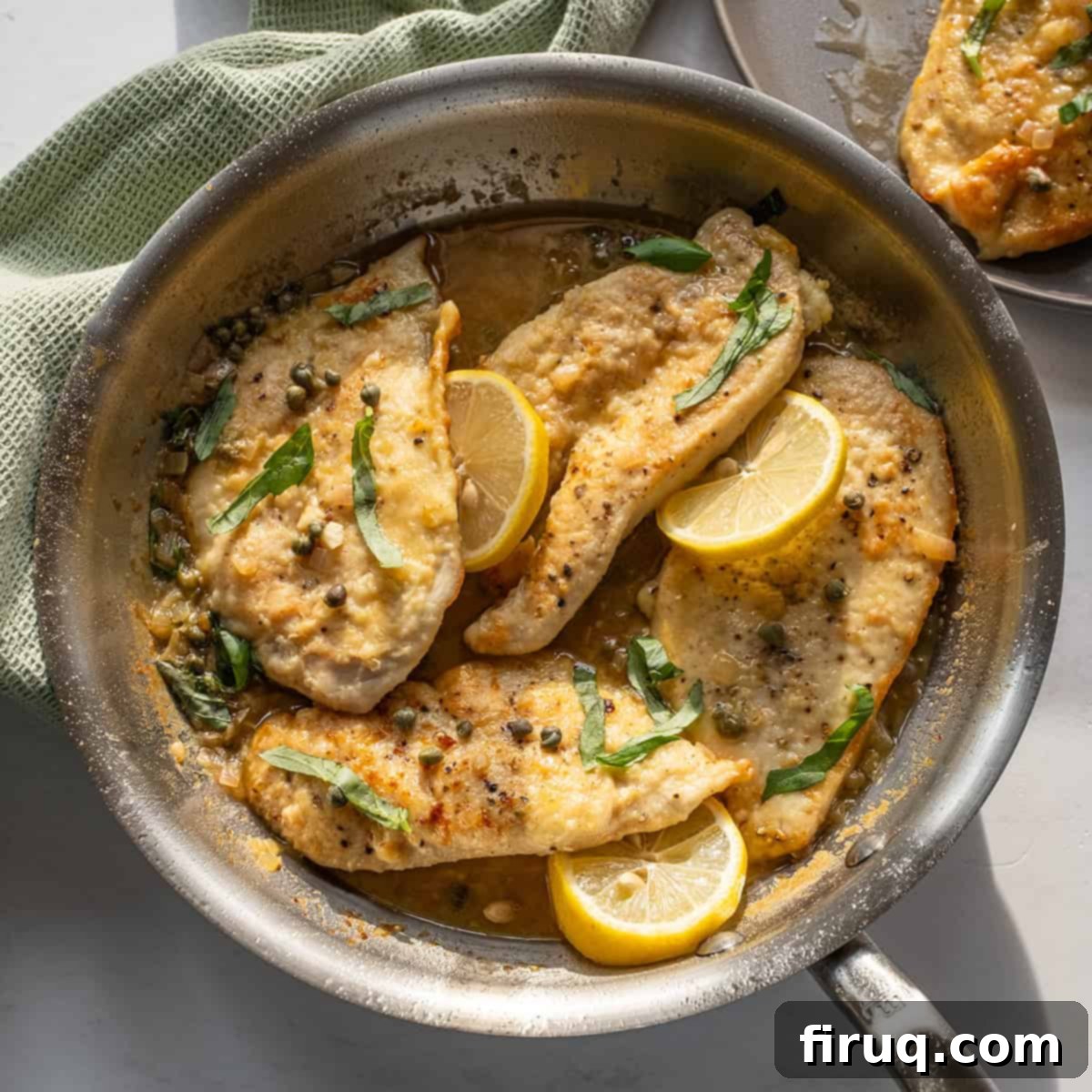Authentic Chicken Piccata: Your Guide to a Tender, Flavorful Italian-American Classic
Welcome to the ultimate guide for preparing the BEST Chicken Piccata you’ll ever taste. This classic Italian-American dish features tenderly fried chicken breasts enveloped in a vibrant, zesty lemon-wine-caper sauce, creating a symphony of delicious flavor and an irresistibly enticing texture. It’s a culinary masterpiece that promises to delight your palate and impress your guests, yet it’s surprisingly easy to master. Perfect for a weeknight dinner or a special occasion, this recipe comes together in under an hour, proving that extraordinary meals don’t have to be complicated. You’ll love serving this versatile dish over fluffy rice or al dente pasta, soaking up every last drop of that incredible sauce.
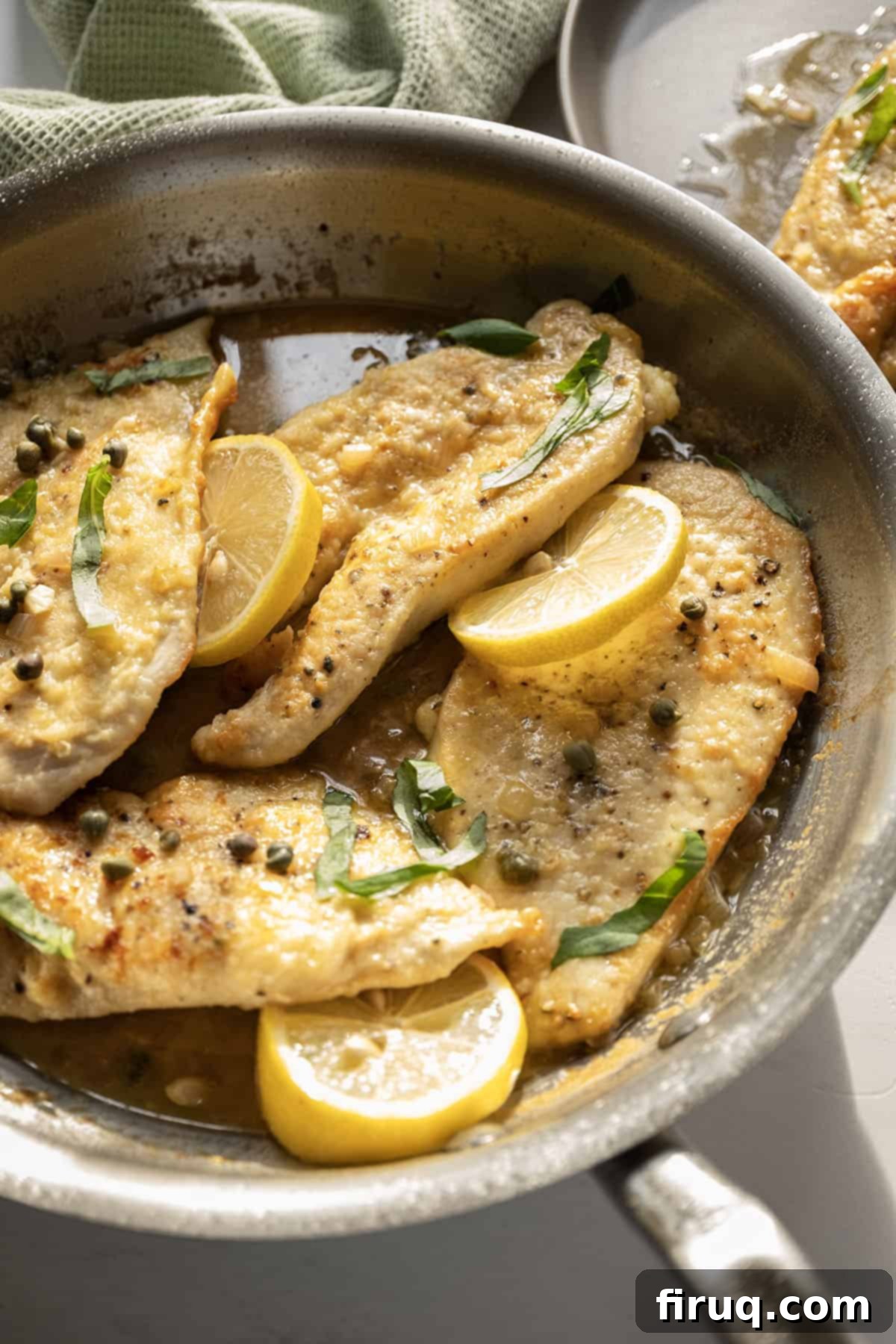
If the bright and tangy flavors of this chicken piccata sauce captivate your taste buds, you might also enjoy exploring our other exquisite sauce recipes such as our Creamy Lemon Sauce, perfect for adding a rich citrusy touch to various dishes, or delve into The Ultimate Guide to Marinara Sauce for a classic Italian staple.
Preparing a truly authentic chicken piccata is about more than just cooking; it’s about understanding the balance of flavors and techniques that define this beloved dish. We’ll walk you through every step, ensuring your chicken is perfectly tender, and your sauce is perfectly balanced – rich, tangy, and utterly irresistible. This recipe is designed for home cooks of all skill levels, allowing you to bring the taste of a fine Italian restaurant right into your kitchen.
[feast_advanced_jump_to]
Chicken Piccata or Chicken Francese: Understanding the Delicious Differences
Often, home cooks find themselves pondering the subtle yet distinct differences between two beloved Italian-American chicken dishes: Chicken Piccata and Chicken Francese. Both are undeniably delicious and share some common elements, but their preparation and flavor profiles set them apart. Chicken Francese typically features chicken breasts that are first dredged in flour, then dipped in an egg batter, and finally pan-fried. This results in a slightly thicker, richer, and more substantial coating on the chicken. Our Restaurant-Style Chicken Francese offers a wonderful example of this hearty preparation.
Chicken Piccata, on the other hand, boasts a more delicate touch. The chicken breasts are simply dredged in a single layer of flour before being pan-fried. This lighter coating allows the tender chicken to truly shine, making it feel less heavy than its Francese counterpart. The hallmark of Piccata lies in its bright, tangy sauce, which prominently features capers – small, briny flower buds that add a unique burst of salty, sour flavor. While capers can be added to Francese, they are an essential and defining characteristic of Piccata.
Overall, while these dishes share a common base of tender chicken and a flavorful sauce, they cater to slightly different preferences. Chicken Francese offers a more robust, eggy texture, while Chicken Piccata provides a lighter, brighter, and more nuanced flavor profile. I personally lean towards piccata not just for its exquisite taste and delicate texture, but also because its preparation, involving only a single flour dredge, tends to be a little less messy in the kitchen than dealing with egg batter.
Essential Ingredient Notes and Smart Substitutions for Perfect Piccata
The success of your Chicken Piccata hinges on the quality and freshness of its ingredients. Each component plays a vital role in building the dish’s signature bright and savory profile. Here’s a detailed look at the key ingredients and some helpful substitution tips.
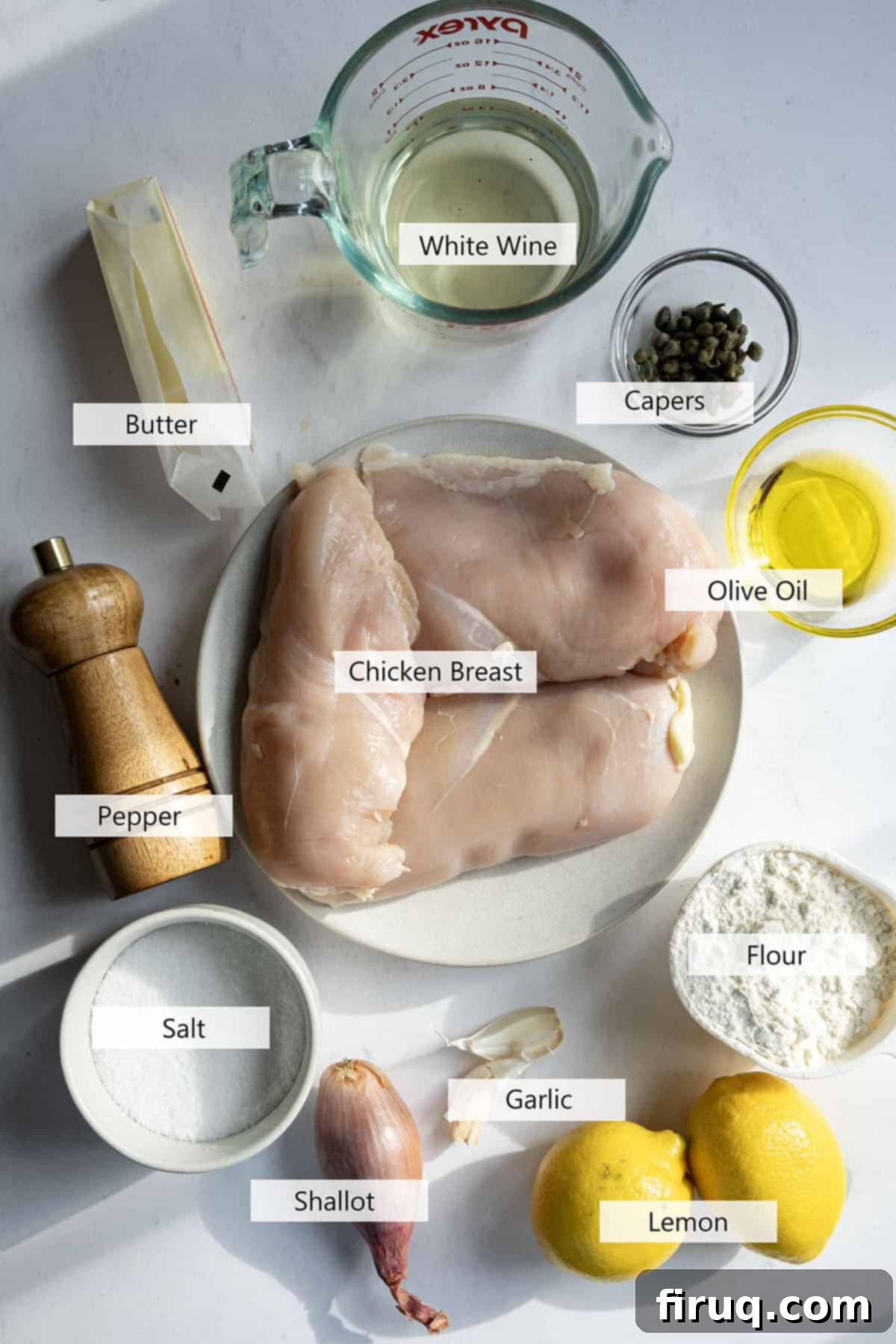
- Chicken Breast: Start with high-quality chicken breasts. When purchasing, always check for firm, well-colored meat that doesn’t appear to be peeling or discolored. Butterflying and tenderizing the chicken ensures even cooking and a delightfully tender result. For a slightly richer flavor and juicier texture, you could substitute well-tenderized boneless, skinless chicken thighs, though breast is traditional for piccata.
- Shallot: The delicate, sweet, and mild flavor of a finely minced shallot forms the aromatic backbone of this sauce. While you can substitute with finely minced yellow or white onion if absolutely necessary, be aware that shallots provide a more refined and less pungent taste, which is definitely preferred in this elegant dish.
- White Wine: A dry white wine is crucial for deglazing the pan and building the complex flavor of the sauce. I highly recommend a crisp sauvignon blanc or a bright pinot grigio. If you prefer not to cook with wine, or don’t have any on hand, an equal amount of good quality chicken broth can be used as a substitute, though it will slightly alter the depth of flavor.
- Capers: These briny, tangy flower buds are non-negotiable for authentic Chicken Piccata. While you *could* technically leave them out if you intensely dislike them, doing so would fundamentally change the dish. Without capers, it simply wouldn’t be Chicken Piccata; it would be closer to a delicious Chicken Breast in Lemon Butter Sauce. They provide that signature salty-sour counterpoint that defines the dish.
- Garlic: Freshly minced garlic, combined with the shallot, infuses the sauce with an aromatic depth that is absolutely essential. Avoid pre-minced jarred garlic for the best flavor.
- Lemon: Fresh lemon juice is paramount. Do not substitute lemon concentrate or artificial lemon flavor, as these lack the nuanced acidity and natural sugars found in fresh lemons. The natural sugars and bright acidity from fresh lemons not only provide the iconic tangy flavor but also contribute to the sauce’s slight thickening and overall intensity. Always use fresh lemons for the best results.
- Butter: Unsalted butter adds richness and helps to emulsify the sauce, giving it a glossy, luxurious finish. Adding it at the end over low heat is key to prevent it from separating.
*For exact measurements and additional information regarding each ingredient, please refer to the comprehensive recipe card provided further down below.
Mastering Chicken Piccata: A Step-by-Step Culinary Journey
Creating this exquisite chicken piccata might seem daunting, but it’s a surprisingly straightforward process, culminating in a restaurant-quality meal that can be prepared in under an hour. This makes it an ideal choice for a perfect weeknight dinner, offering sophisticated flavors with minimal fuss. Follow these detailed steps to achieve piccata perfection.
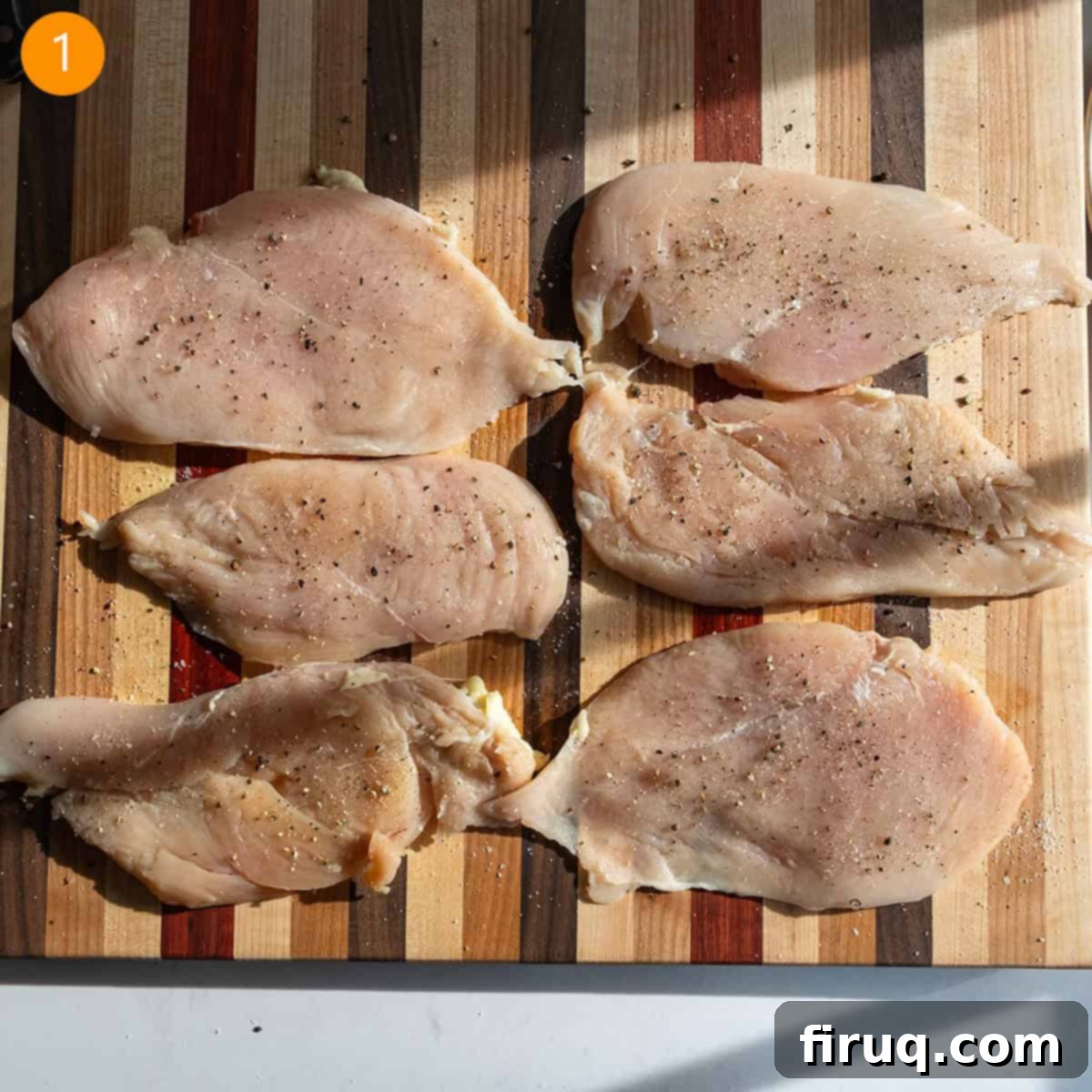
Step 1: Prepare the Chicken. Begin by butterflying each chicken breast to create thinner, even pieces. Then, tenderize them gently using a meat mallet or the back of a heavy pan. This ensures uniform thickness for even cooking and a more tender final product. Season both sides generously with salt and freshly ground black pepper.
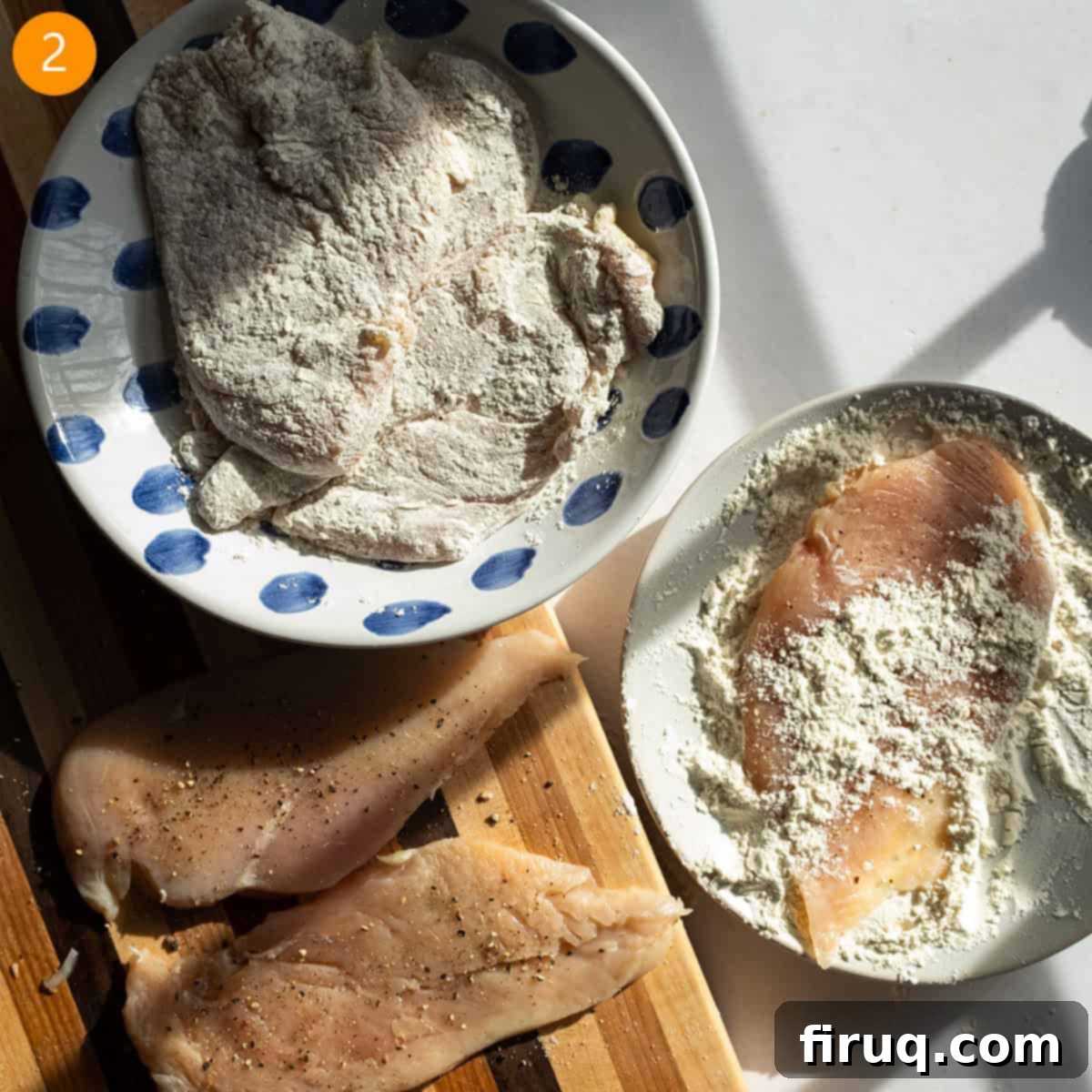
Step 2: Dredge the Chicken. Spread 1 cup of all-purpose flour onto a shallow plate. Take each seasoned chicken breast and thoroughly dredge it through the flour, ensuring it’s completely and evenly coated. Gently shake off any excess flour. Place the floured chicken pieces on a separate clean plate, ready for frying.
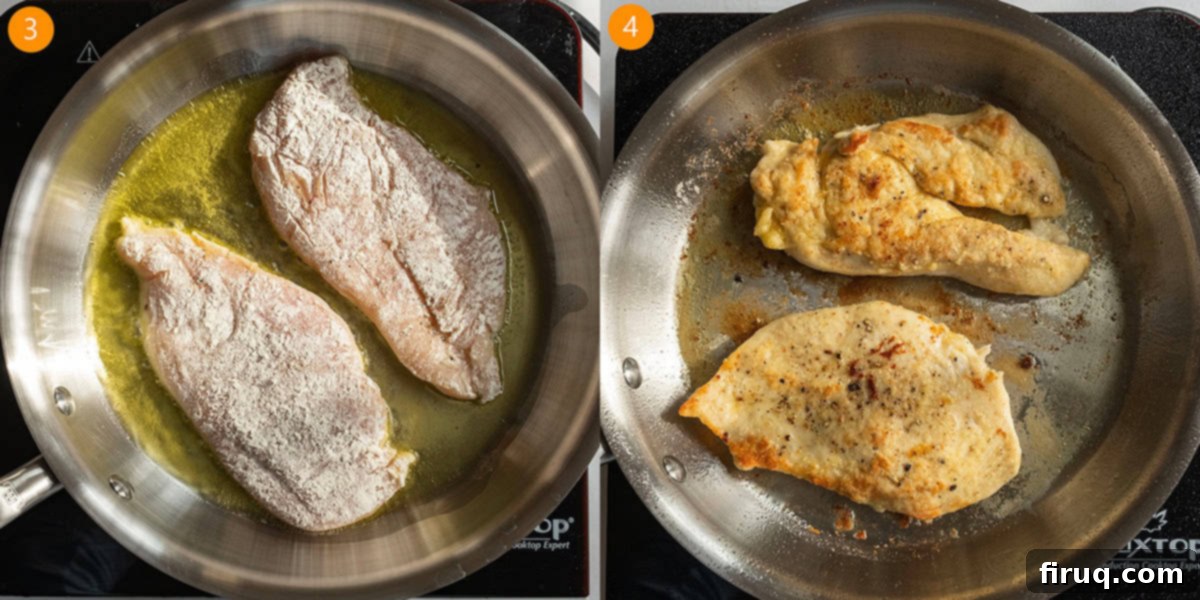
Step 3: Pan-Fry the Chicken. Heat half of the specified olive oil in a large saucepan over medium heat. Once the oil is shimmering and hot, carefully add the floured chicken breasts to the pan. Avoid overcrowding; if necessary, fry the chicken in batches to ensure even browning. Cook for 3-4 minutes on each side, or until the chicken achieves a beautiful golden-brown crust and reaches an internal temperature of 165 ℉ (74 °C). This golden crust contributes significantly to the dish’s flavor and texture.
Step 4: Rest the Chicken. As each batch of chicken finishes cooking, transfer it to a plate lined with paper towels to absorb any excess oil. This keeps the chicken crisp while you cook the remaining pieces and prepare the sauce. Add more olive oil to the pan between batches if needed to maintain an adequate frying medium.
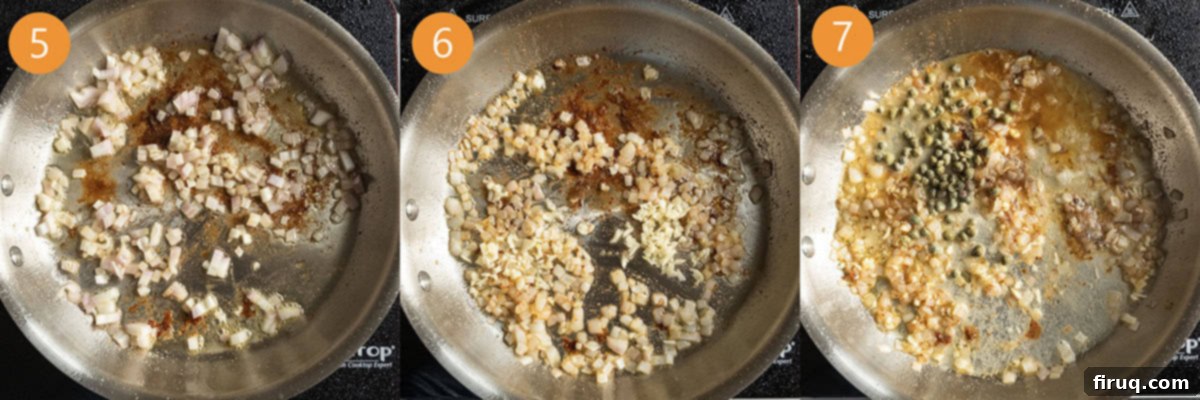
Step 5: Sauté the Aromatics. Once all the chicken is cooked and set aside, add 1 additional tablespoon of olive oil to the same pan (no need to clean it, those browned bits add flavor!). Reduce the heat to medium-low. Add the finely chopped shallot and sauté gently for 3-4 minutes, until it softens and becomes translucent, releasing its sweet aroma.
Step 6: Infuse with Garlic. Stir in the minced garlic and continue to sauté for another 1-2 minutes. Be careful not to burn the garlic, as this can make it bitter. You’re looking for a fragrant aroma to fill your kitchen.
Step 7: Build the Lemon-Caper Base. Squeeze in the fresh lemon juice directly into the pan and add the capers. Allow this mixture to simmer gently on medium-low heat. The natural sugars in the lemon juice will begin to caramelize slightly and thicken, intensifying the bright, tangy flavor profile of the sauce. This step is crucial for achieving that signature piccata tang.
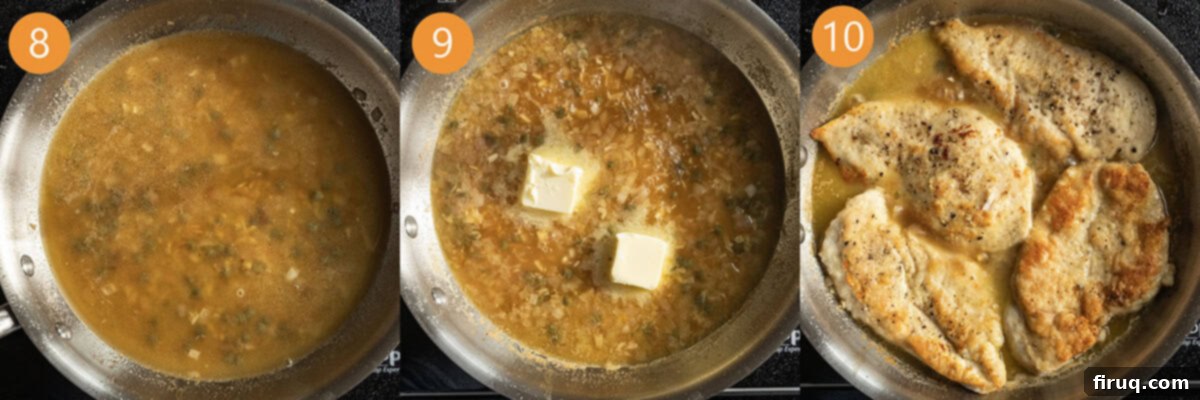
Step 8: Deglaze with Wine. Pour in the white wine. Raise the heat to medium and bring the sauce to a gentle simmer. Let it simmer for about 5 minutes, allowing the alcohol to cook off and the flavors to meld beautifully. As it simmers, use a wooden spoon to gently scrape up any flavorful brown bits (fond) from the bottom of the pan. These bits are packed with flavor and will enrich your sauce significantly.
Step 9: Enrich with Butter. Once the wine has simmered, lower the heat to low. Add the cold butter to the sauce and stir continuously until it is completely melted and incorporated. This process, known as “monter au beurre,” creates a smooth, glossy, and rich sauce that is the hallmark of a great piccata. The low heat prevents the butter from separating.
Step 10: Combine and Coat. Carefully return the previously fried chicken breasts to the pan with the now luscious sauce. Gently flip the chicken pieces, ensuring each one is thoroughly coated in the warm, zesty sauce. Allow the chicken to warm through for a minute or two, absorbing the wonderful flavors.
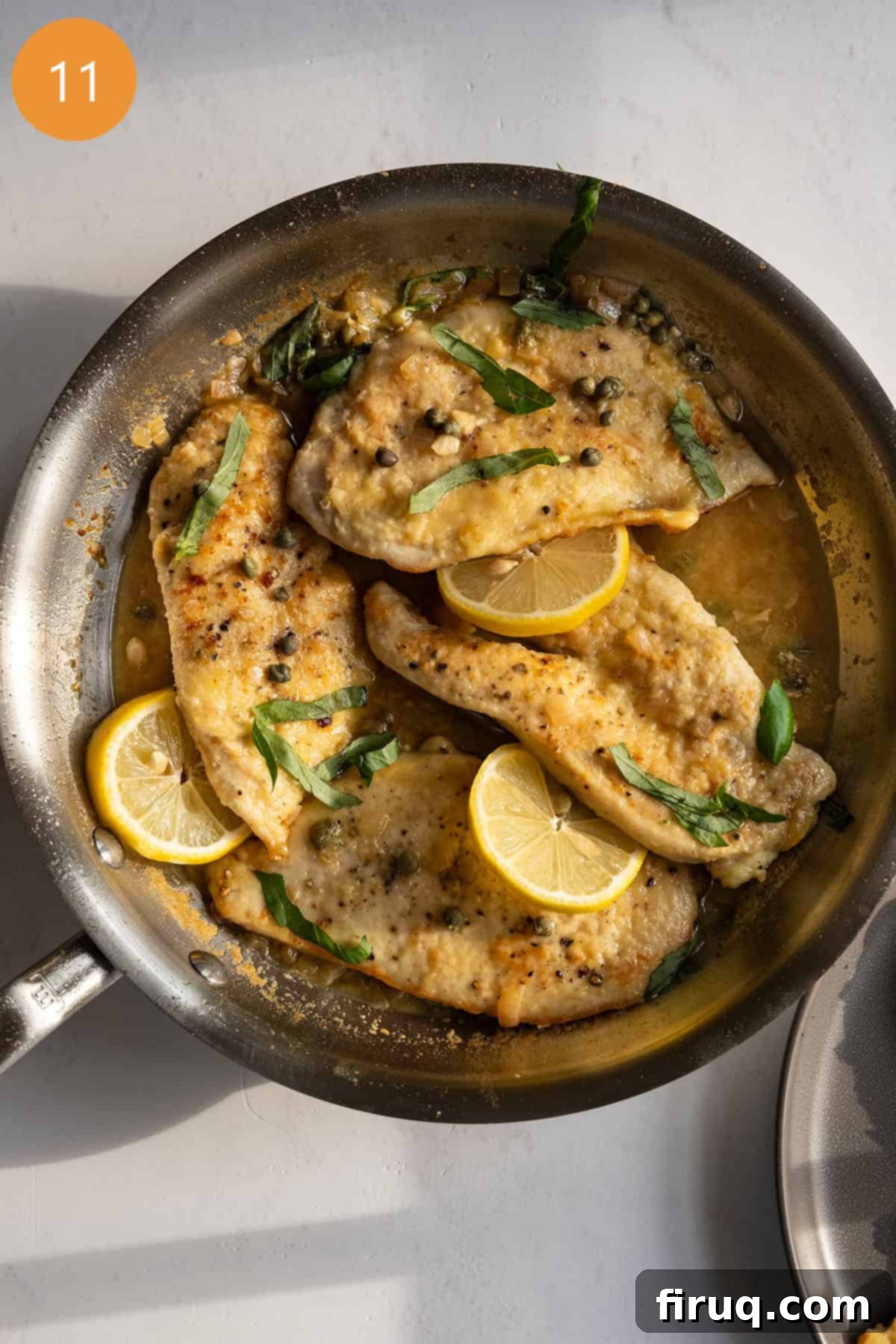
Step 11: Garnish and Serve. For a final flourish, sprinkle generously with fresh julienned basil and, if desired, a few extra fresh lemon slices or a squeeze of fresh lemon juice. Chicken Piccata is exceptionally versatile and delicious served over a bed of fluffy rice or a generous portion of angel hair pasta. This incredible sauce also pairs perfectly with delicate side dishes like Lemon Spinach Orzo for a complete and satisfying meal.
Pro-Tips for Your Best Chicken Piccata
Achieving a truly outstanding Chicken Piccata involves more than just following steps; it’s about understanding the nuances that elevate the dish. These professional tips will help you perfect your technique and ensure a consistently delicious outcome every time:
- Timing Your Flour Dredge is Key: Do not flour the chicken too far in advance of frying. If the chicken sits for too long after being floured, the moisture from the chicken will absorb the flour, making it gummy and causing it to stick to the pan rather than forming a crisp, golden crust. Flour just before you’re ready to fry.
- Fry in Batches for Perfect Browning: Overcrowding the pan lowers the oil temperature, leading to steamed chicken rather than beautifully fried pieces. Always fry the chicken in batches, ensuring there’s ample space around each piece and plenty of hot olive oil. This guarantees a golden-brown, evenly cooked exterior on every piece.
- Embrace the Fond for Flavor Depth: Don’t worry if some delicious brown bits (known as “fond”) are left behind in the pan after frying the chicken. These are pure flavor! These caramelized chicken and flour particles will release into your sauce during the deglazing step, adding incredible depth and richness to the overall taste profile.
- Intensify Lemon Flavor with Simmering: For the most vibrant and concentrated lemon flavor, allow the lemon juice and capers to simmer together until the lemon juice begins to visibly thicken. This gentle reduction helps to intensify the natural sugars and acidity, creating a more robust and complex citrus note in the final wine sauce.
- Add Butter on Low Heat for a Silky Sauce: The secret to a perfectly emulsified, glossy sauce is to add the butter only when the heat has been lowered to low. Stir constantly as the butter melts and incorporates. High heat will cause the butterfat and water to separate, resulting in a greasy, broken sauce instead of a smooth, velvety one.
Chicken Piccata: Your Most Asked Questions Answered
Here, we address some of the most common questions about Chicken Piccata to help you better understand and prepare this classic dish.
Chicken piccata is a classic Italian-American dish primarily made from thinly sliced or butterflied chicken breasts. These are typically dredged in flour and then pan-fried until golden. The cooked chicken is then tossed in a vibrant, zesty sauce made from fresh lemon juice, dry white wine, butter, and briny capers, often garnished with fresh basil or parsley. It’s usually served with a side of rice pilaf or light pasta like angel hair to soak up the delicious sauce.
While both are popular Italian-American chicken dishes, their flavor profiles and key ingredients are quite distinct. Chicken piccata is characterized by its bright, tangy, and zesty lemon, white wine, and caper sauce. In contrast, Chicken Marsala features a rich, savory, and often umami-rich sauce made with Marsala wine, mushrooms, and sometimes shallots. Marsala sauce is typically a darker, brown sauce, while piccata sauce is lighter in color, leaning towards yellow due to the lemon and white wine.
Several factors can contribute to a bitter chicken piccata. One common reason is not simmering the white wine long enough to cook off its alcohol and allow its flavors to mellow; residual raw alcohol can impart bitterness. Another frequent cause is burning the garlic during the sautéing process, which can quickly turn sweet garlic bitter. Ensure you sauté garlic on medium-low heat and only until fragrant, not browned. Also, be mindful of how you squeeze your lemons; avoid pressing too hard on the pith (the white part of the peel), as it can release bitter oils.
Technically, you can skip any ingredient in your cooking if it’s not to your preference. However, when it comes to Chicken Piccata, capers are one of the defining elements that give the dish its unique briny, tangy, and slightly salty character. Without them, the dish loses a significant part of its identity and might taste more like a generic lemon-butter chicken. While it might still be delicious, it wouldn’t truly be “piccata.” That being said, it’s your meal, so feel free to adapt it to your taste!
Perfect Pairings: What to Serve with Chicken Piccata
Chicken piccata is a wonderfully versatile main dish that shines even brighter when paired with the right accompaniments. Its bright, tangy sauce complements a wide array of side dishes, from crisp vegetables to comforting starches and refreshing salads. Here are some fantastic suggestions to complete your meal:
- Fresh Vegetables: To balance the richness of the chicken and sauce, a side of fresh, vibrant greens is always a good idea. Consider serving it with the BEST Garlic Parmesan Green Beans for a flavorful crunch, or opt for the slightly bitter and earthy notes of Sautéed Rapini with Garlic. For a truly Italian touch, our Italian Lacinato Kale Recipe (Tuscan) provides a healthy and delicious complement.
- Hearty Starches: The luscious piccata sauce is begging to be sopped up! Classic choices include serving the chicken over fluffy white rice or delicate angel hair pasta, which perfectly absorbs the sauce. To elevate your starch game, try our Crispy Garlic Parmesan Potatoes for a savory and satisfying option. If you want to take your pasta pairing to the next level, a side of Lemon Pasta with Spinach or Artichoke Pesto Pasta would create an unforgettable Italian feast.
- Crisp Salads: A fresh, crisp salad can provide a refreshing contrast to the rich flavors of chicken piccata. A classic Caesar salad is always a winning choice, especially when made with our Traditional Caesar Dressing and topped with crunchy Homemade Italian Parmesan Croutons. The crisp lettuce and tangy dressing will cleanse the palate beautifully.
Explore More Classic Italian Chicken Dishes
If you’ve fallen in love with the vibrant flavors of Chicken Piccata, you’re in for a treat! The world of Italian-American cuisine is rich with incredible chicken recipes that offer diverse taste experiences, from hearty stews to elegant pan-fried preparations. Each dish tells a story of tradition and flavor, and we invite you to explore more of our favorites:
- Easy Chicken Cacciatore
- Fennel Chicken Thighs in Red Wine
- Restaurant-Style Chicken Scarpariello
- Restaurant-Style Chicken Saltimbocca
We absolutely love hearing from you and seeing your culinary creations! Please take a moment to leave a comment and a star rating below in the recipe card once you’ve tried our recipes. Your feedback is invaluable to us. And don’t forget to tag us on Instagram @vindelgiudice – we love to share your delicious results!
📖 Recipe
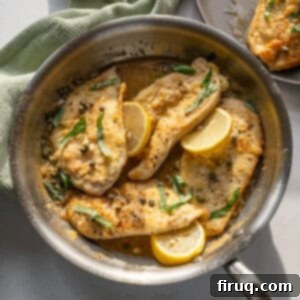
The BEST Chicken Piccata
Vincent DelGiudice
Pin Recipe
Equipment
-
1 large saucepan
-
1 large plate
Ingredients
- 3 chicken breast, butterflied
- 1 teaspoon salt
- 1 teaspoon pepper
- 1 cup flour
- ¼ cup olive oil
- 1 shallot, chopped
- 2 cloves garlic, minced
- 2 lemons
- 2 tablespoon capers
- 1 cup white wine
- 4 tablespoon butter
- 2 tablespoon basil, julienned
Instructions
-
Butterfly the chicken breast and tenderize it until uniformly thin. Then season both sides generously with salt and pepper. Pour 1 cup of all-purpose flour onto a plate and thoroughly dredge each chicken piece through the flour until completely covered, shaking off any excess. Set the floured chicken on a separate clean plate.
-
Add half the olive oil to a large saucepan and heat over medium heat. Once hot and shimmering, carefully add the floured chicken (in batches if necessary to avoid overcrowding) and fry for 3-4 minutes on each side until golden brown and cooked through to an internal temperature of 165 ℉ (74 °C). As each batch finishes, transfer the chicken to a paper towel-lined plate to rest, adding more olive oil to the pan as needed for subsequent batches.
-
In the same pan (do not clean it, the fond adds flavor!), add 1 tablespoon of olive oil. Lower the heat to medium-low. Add the chopped shallot and sauté for 3-4 minutes until softened and translucent. Then, stir in the minced garlic and sauté for an additional 1-2 minutes until fragrant, being careful not to burn it.
-
Squeeze in the fresh lemon juice and add the capers to the pan. Allow the lemon juice to simmer gently on medium-low heat until it begins to thicken slightly, intensifying its flavor. Then, pour in the white wine, raise the heat to medium, and bring the sauce to a simmer. Let it simmer for 5 minutes, using a wooden spoon to scrape up any browned bits from the bottom of the pan to incorporate them into the sauce.
-
Lower the heat back to low. Add the cold butter to the simmering sauce and stir continuously until the butter is completely melted and smoothly combined, creating a glossy, emulsified sauce. Return the cooked chicken breasts to the pan, flipping them gently to thoroughly coat each piece in the luscious piccata sauce. Top with fresh julienned basil before serving immediately.
Notes
- Don’t flour the chicken too far in advance. The chicken will soak it up and stick to the pan.
- Fry the chicken in batches and make sure there is plenty of oil with each batch.
- It’s okay if some burnt brown bits are left behind in the pan while frying. This will flavor the sauce.
- Simmer the capers and lemon together until the lemon thickens to get the most intense lemon flavor added to the wine sauce.
- Only add the butter to the sauce when the heat is lowered. This way the sauce and butter emulsify and don’t become separated.
